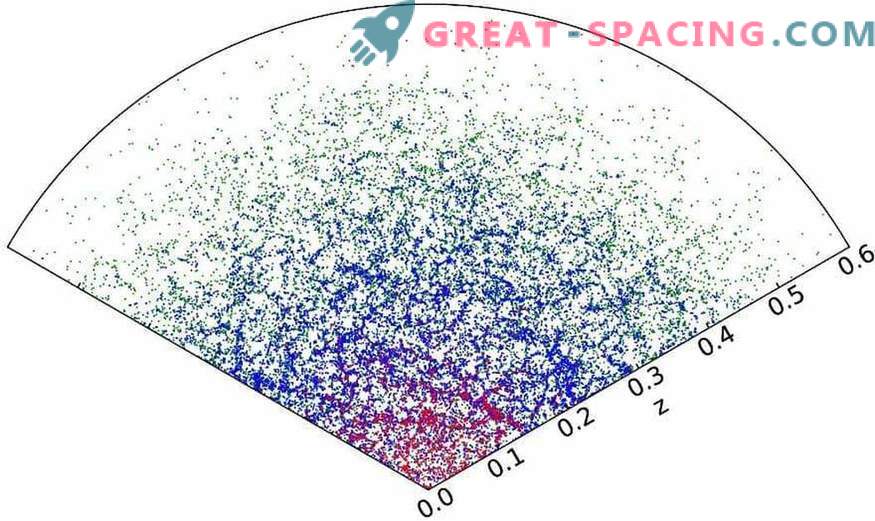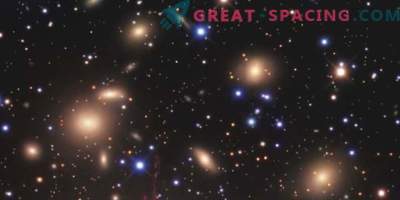
To see is to believe? Scientists create simulated universes complete with mock dark matter, galaxies, quasi-quasars, and pseudo-supernovae to better understand real observations.
Their goal is to imagine how new observations on Earth and space research will see the Universe. The apparatus used was called Dark Energy Spectroscopic Instrument (DESI). The project is scheduled to begin in 2019.

The graph displays a thin slice in the catalog of false galaxies. Blue and green dots are bright and weak galaxies modeled by the Dark Energy Spectroscopic Instrument. Red dots - galaxies whose brightness exceeds the values of the Sloan digital celestial survey
Several teams form separate models filled with various objects that DESI will encounter.
New models focus on previous observations and large-scale universe simulations that take into account complex physics, as well as dark matter - an unknown form of matter, which, together with dark energy, takes up 95% of the total mass and energy of space.
Of course, there is a whole database, but DESI will see a new image. Modeled objects and universes, created and enhanced by powerful supercomputers, should take into account the atmospheric noise of the Earth, as well as weather conditions, lighting and lunar phases affecting observations. DESI will be installed on a 4-meter telescope at Kit Peak National Observatory (Arizona). It will measure light from tens of millions of galaxies and other objects with an array of 5,000 rotating robots. The robotic array will cycle through a sequence of objects, looking up to 11 billion years ago at the beginning of the universe.
The animation demonstrates a scaled representation of the distribution of dark matter in space. Based on Millennium Modeling. Extends from the scale of several billion parsecs to less than 10,000 parsecs
The light captured by DESI will provide accurate measurements that will help restore the evolution of the Universe and learn more information about dark energy. The latter is especially important, because it is she who is responsible for the spatial expansion.
One of the simulations is the Millennium XXL created in Germany. For the formation of used 12,000 computer cores, which equates to 300 years of computer operation. The layout of the galaxy focused on the same part of the sky that DESI would explore. The catalog shows how the redshift changes over time and will be displayed in DESI.
Due to cosmic expansion, distant objects look redder and weaker. However, earlier catalogs did not take into account changes in redshift.

Predicted distribution of galaxies in the Millennium-XXL simulation. Each galaxy is represented by a sphere whose intensity and size are related to the expected total mass in the stars and the size of the disk with a cool gas. The team used the “halo employment distribution” method to model the average number of galaxies and their brightness based on Millennium-XXL. In dark matter models, halos are created, enveloping galaxies.
The galaxies in the catalog are simplified to the brightness level, because they will be displayed in one of the wavelength ranges scanned by DESI. The layout catalog is also intended to imitate galactic types. Separate simulations will take into account the darker viewing conditions.
But the DESI team will not stop there. Even after starting the program, they will continue to adapt and improve the model.

Here are some of the targets for the DESI Observatory, as well as overlay images showing mock spectra and light captions.
Experts do not forget that faith in the simulation will not bring a reliable vision of the universe. Therefore, it is necessary to check everything in reality with particular accuracy. For example, it is especially difficult to model quasars. But scientists insist that we need catalogs with the most realistic layouts of objects in order to improve the measurement accuracy of the real Universe.











































